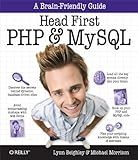Best PHP Date and Time Books to Buy in November 2025

PHP & MySQL: Server-side Web Development



Programming PHP: Creating Dynamic Web Pages



Front-End Back-End Development with HTML, CSS, JavaScript, jQuery, PHP, and MySQL



PHP and MySQL: The Comprehensive Guide to Server-Side Web Development with PHP 8 – Build Dynamic Websites with Database Integration, Security, and More (Rheinwerk Computing)



Murach's PHP and MySQL (4th Edition) Professional Web Development Guide for Learning PHP & MySQL Database Programming - Beginner-Friendly Coding Book with MVC Pattern & Security Features



Head First PHP & MySQL: A Brain-Friendly Guide


In PHP, there are several functions and classes available to help you work with dates and times. These functions allow you to manipulate dates, format them, calculate intervals, and much more.
- Date and Time Functions: time(): Returns the current Unix timestamp. date(format, timestamp): Formats a timestamp into a specific date/time representation. strtotime(time, now): Parses any English textual datetime description into a Unix timestamp. mktime(hour, minute, second, month, day, year): Returns the Unix timestamp for a specified date and time. getdate(timestamp): Returns an associative array containing various details for a given timestamp.
- Date and Time Formats: d: Day of the month as a two-digit number (01 to 31). m: Month as a two-digit number (01 to 12). Y: A four-digit representation of the year. H: Hour in 24-hour format (00 to 23). i: Minutes with leading zeros (00 to 59). s: Seconds with leading zeros (00 to 59).
- Date and Time Manipulation: strtotime('+5 days'): Adds a specific time interval to the current date. strtotime('-2 weeks'): Subtracts a specific time interval from the current date. date_modify(object, modify): Modify a given DateTime object using a relative format.
- Timezone Settings: date_default_timezone_set(zone): Sets the default timezone used by all date/time functions. date_default_timezone_get(): Gets the default timezone used by all date/time functions.
- DateTime Class: The DateTime class provides more advanced date and time manipulation capabilities. DateTime::format(format): Formats a date according to the specified format. DateTime::add(interval): Adds an interval to a date. DateTime::sub(interval): Subtracts an interval from a date. DateTime::diff(datetime2): Returns the difference between two DateTime objects.
Remember to set the correct timezone before working with dates and times to ensure accurate operations. PHP provides various options for working with dates and times, so choose the one that best suits your requirements.
How to add hours to a time in PHP?
In PHP, you can use the strtotime() function along with the date() function to add hours to a specific time. Here's a simple example:
$time = "10:30:15"; $hoursToAdd = 2;
// Convert time to seconds $timeInSeconds = strtotime($time);
// Add hours to the time $timeWithAddedHours = $timeInSeconds + ($hoursToAdd * 60 * 60);
// Format the result back to the time format $newTime = date("H:i:s", $timeWithAddedHours);
echo $newTime; // Output: 12:30:15
In the example above, we start by defining the original time and the number of hours to add. We then use the strtotime() function to convert the time string to seconds.
Next, we calculate the total number of seconds to add by multiplying the hours to add by 60 (minutes) and 60 (seconds). We add this value to the original time in seconds.
Finally, we use the date() function to format the new time back to the original time format (H:i:s) and store it in the $newTime variable. Finally, we echo the new time.
You can customize the time format by changing the string in the second argument of the date() function. For example, "H:i" will output only the hour and minute (e.g., 12:30), and "g:i A" will output the time in a 12-hour format with AM/PM indicator (e.g., 12:30 PM).
How to get the first day of the month in PHP?
To get the first day of the month in PHP, you can use the date() function along with the strtotime() function. Here is an example:
$firstDayOfMonth = date("Y-m-01");
In this example, date() is used to format the current date as YYYY-MM-01, which represents the first day of the current month.
How to get the day of the week from a date in PHP?
You can use the date() function in PHP to get the day of the week from a date. Here's an example code:
$date = '2021-09-30'; // Your date here
$dayOfWeek = date('l', strtotime($date)); echo $dayOfWeek; // Output: Thursday
Explanation:
- Set the desired date in the format 'YYYY-MM-DD' to the $date variable.
- Use the strtotime() function to convert the date string to a Unix timestamp.
- Use the date() function with the format identifier 'l' to get the full day of the week.
- Store the day of the week in the $dayOfWeek variable.
- Finally, print or use the $dayOfWeek variable to get the day of the week.
Note: 'l' returns the day of the week in full name, e.g., "Monday". If you want it to return the short name, e.g., "Mon", you can use 'D' instead of 'l' in the date() function.
How to convert a timestamp to a date in PHP?
To convert a timestamp to a date in PHP, you can use the date() function. Here is an example:
$timestamp = 1577836800; // Example timestamp (January 1, 2020) $date = date('Y-m-d', $timestamp); echo $date; // Output: 2020-01-01
In the above example, the date() function formats the timestamp according to the provided format string 'Y-m-d', which represents the year, month, and day. The second argument is the timestamp value, which is passed as $timestamp.
You can modify the format string based on your requirements. For example, if you want to include the time as well, you can use 'Y-m-d H:i:s'.
How to compare two dates in PHP?
In PHP, you can compare two dates using the DateTime class and its methods. Here's how you can perform date comparison in PHP:
- Create two DateTime objects for the dates you want to compare:
$date1 = new DateTime('2022-01-10'); $date2 = new DateTime('2021-12-15');
- Use the comparison operator (<, <=, >, >=, ==, !=) to compare the DateTime objects:
if ($date1 < $date2) { echo "Date 1 is earlier than Date 2"; } elseif ($date1 > $date2) { echo "Date 1 is later than Date 2"; } else { echo "Both dates are equal"; }
- Alternatively, you can use the diff method to get the difference between the two dates as a DateInterval object:
$interval = $date1->diff($date2);
if ($interval->invert == 1) { echo "Date 1 is later than Date 2"; } elseif ($interval->invert == 0) { echo "Both dates are equal"; } else { echo "Date 1 is earlier than Date 2"; }
Here, the invert property of the DateInterval object is used to determine if Date 1 is earlier or later than Date 2. If invert is 1, Date 1 is later, and if it's 0, both dates are equal.
